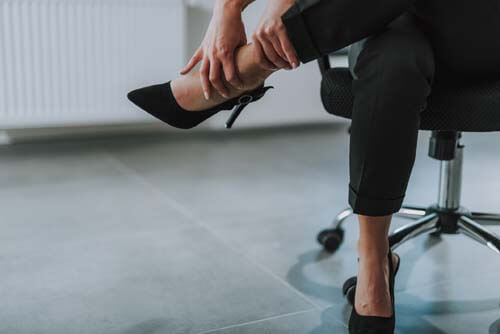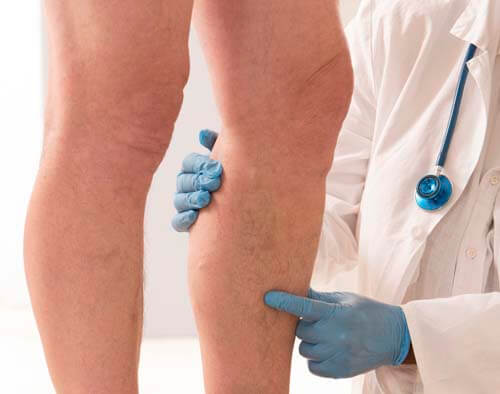While you can’t change the genetic factors that make you prone to varicose veins, there are proven actions you can take that will keep existing varicose veins from worsening and possibly even forestall their appearance. And, to help motivate you, the same lifestyle habits that can help prevent varicose veins will improve your health in a variety of other ways. What could be better?
EXERCISE

Where varicose vein prevention is concerned exercise is at the top of the list. It’s important to have a regular exercise routine that will tone your cardiovascular system, strengthen your legs, and promote flexibility. Walking, cycling and swimming are good choices of exercises that check off the first two items. And don’t forget about dancing!
Specific exercises that target the calf muscles should also be included in your exercise routine. Having strong calf muscles can lessen the effects of faulty valves, which makes calf strengthening exercises that much more important. Studies have shown that, even with venous insufficiency, it’s possible to regain normal calf pump function through exercise[1]. Talk with your doctor or a personal trainer for advice on an exercise program that best suits your individual needs and interests.
Finally, your exercise program should include a flexibility component. Flexibility promotes healthy circulation and prevents muscle and joint injuries. You can practice yoga or devise a routine of stretches you enjoy. Spot stretches can target the lower legs and should be done on a daily basis throughout the day. For best effects aim for a full body stretching program at least once per week.
WATCH YOUR WEIGHT
Excess weight increases the blood pressure in your veins, putting additional stress on already weak valves. Obesity is also associated with higher levels of inflammation which triggers problems within the inner linings of the veins that contribute to poor blood flow. A healthy diet for preventing varicose veins should include plenty of high-fiber foods and healthy fats, while avoiding foods that cause or contribute to vein problems, such as sugary, salty, and processed foods and trans fats. If weight loss is on your list consider consulting with a qualified health professional who can formulate a diet that you will enjoy and will emphasize protecting your circulatory system.
CHANGE YOUR SITTING OR STANDING POSITION REGULARLY

If you have a desk job that requires long hours of sitting look for ways to change position occasionally.
There are some simple exercises you can do right at your desk that will decrease pressure in your legs and activate the muscular pump that helps move blood upwards. These exercises don’t take the place of recreational exercise but they can help get your legs through the workday in better shape.
- Ankle circles and peddling motions with your feet are easily done while you work.
- Advanced ankle circles: Trace the alphabet, your name, or the words to your favorite song in the air with your toe. Use your full range of motion to draw big letters. This exercise is fun and improves coordination as well as muscle strength.
- Take a 30 second stretch break: slide your chair back, straighten one leg and flex your toes, then bend forward at the hips until you feel a mild stretch your hamstring and calf muscles. Hold for 10-15 seconds then reverse and switch to the other leg.
Depending on the type of work you do you might be able to add a standing desk or a high counter level surface so that you can alternate sitting and standing while you work. Also, consider using an exercise ball chair. This is a large exercise ball that rests in a frame. The surface of the ball is supportive but slightly unstable, which makes you use your core (abdominal and back) muscles, improving your posture and lower body muscle tone.
If your job requires long hours of standing incorporate these micro exercise breaks can be done in place at your work station:
- Heel raises – Simply raise up onto your toes, hold for a few seconds then release and repeat several times. This strengthens the calf muscles and promotes venous circulation.
- Standing hamstring and calf stretch – alleviates muscle fatigue and increases blood flow. It doesn’t require any special equipment or clothing and can be done in a small space. Shift your weight to one leg and raise the toes of the opposite foot so you’re resting on that heel. Fold forward slightly at the hips until you feel a slight stretch in your hamstring and calf muscles of the outstretched leg.
- Knee raises – Standing in place, start by slowly raising one knee to waist height or as high as you can then lower and repeat with the other leg. To raise your heart rate, gradually increasing your speed. Walk in place this way for 30-60 seconds. This exercise strengthens the hip, gluteal muscles, and calf muscles.
More Useful Tips
Nutritional supplements with specific benefits for the veins and circulation can help offset those risk factors that you can’t control. Here are a few supplements with proven benefits, but as always, please consult your physician before adding any nutritional supplements to your diet:
Rutin is a bioflavonoid antioxidant compound found in some plant foods that is particularly good for circulatory health and preventing blood clots. Rutin has been shown to alleviate varicose vein symptoms in the later stages of pregnancy[2].
Eicosapentaenoic acid (EPA) an essential fatty acid component of fish oil, EPA has been shown to reduce the inflammatory cascade that damages the inner walls of veins and contributes to the development and progression of varicose veins[3].
Vitamin E is a powerful antioxidant known to prevent blood clots. Vitamin E supplementation lowered the risk of venous thrombosis by 37% in a 2015 study[4].
Your choice of clothing can help or hinder your success at preventing varicose veins. Avoid clothing that is tight or restricts movement at the waist, hips, and legs as these will impair circulation. Similarly, avoid tight-fitting shoes and reserve your high heels for special occasions.
Wear compression hosiery to prevent or reduce swelling and discomfort. Your legs will thank you and you’ll feel better at the end of the day. These have been shown to be highly effective at preventing recurrence of varicose veins, with one study reporting only 6% recurrence in participants who wore compressions stockings compared to 71% recurrence in the group that didn’t wear them[5].
Try to avoid crossing your legs. This may cause a difference not only for your legs but for your back as well, making it an all-around good habit to adopt.

And once you’ve gotten your varicose vein prevention habits dialed in consider taking action to resolve your existing varicose vein problems with simple procedures that can permanently resolve painful and unsightly varicose veins.
To learn about these treatments, we invite you to schedule a free consultation at Desert Vein and Vascular Institute. All of our physicians are board-certified vascular surgeons who specialize in helping people like you. Desert Vein and Vascular Institute is the top provider of VenaSealTM, the leading outpatient varicose vein treatment, in the USA.
To schedule a free consultation, please call 1-800-827-4267 today.
References
- Structured exercise improves calf muscle pump function in chronic venous insufficiency: a randomized trial. J Vasc Surg, 2004. 39(1): p. 79-87
https://pubmed.ncbi.nlm.nih.gov/14718821/ - Interventions for varicose veins and leg oedema in pregnancy. Cochrane Database Syst Rev, 2015. 2015(10): p. Cd001066
https://pubmed.ncbi.nlm.nih.gov/26477632/ - EPA + DHA supplementation reduces PMN activation in microenvironment of chronic venous leg ulcers: A randomized, double-blind, controlled study. Wound Repair Regen, 2017. 25(4): p. 680-690
https://pubmed.ncbi.nlm.nih.gov/28758717/ - Vitamin supplementation on the risk of venous thrombosis: results from the MEGA case-control study. Am J Clin Nutr, 2015. 101(3): p. 606-12
- Reduction of Varicose Vein Recurrence by Use of Postoperative Compression Stockings. Phlebology: The Journal of Venous Disease, 1994
https://journals.sagepub.com/doi/abs/10.1177/026835559400900304
https://sci-hub.tw/https://doi.org/10.1177/026835559400900304
